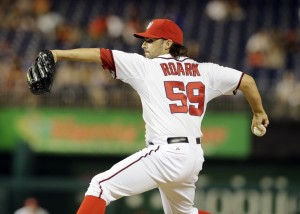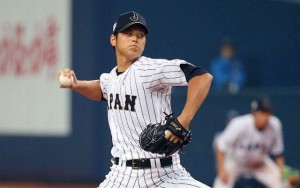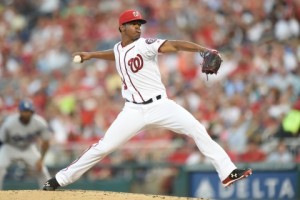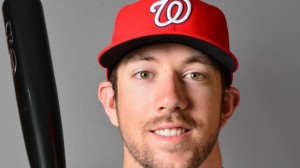Its that time of the year as noted. Lets get right to it.
Nats have 7 arbitration-eligible players. Four of them are no-brainers to tender and negotiate with in Arbitration. 2019 salary guesses are MLBtraderumor estimates that are now pretty well accepted as the best analysis estimates out there. I feel like the Nats are a bit generous and usually end up paying slightly more than their estimates, but these will work for now.
| Arbitration Eligible Player | 2018 salary/contract | 2019 estimate |
|---|---|---|
| Rendon, Anthony | 1 yr/$12.3M (18) | $17.6M |
| Turner, Trea | 1 yr/$0.5772M (18) | $5.3M |
| Ross, Joe | 1 yr/$0.5679M (18) | 1.5M |
| Barraclough, Kyle | 1yr/$1.9M (18) | $1.9M |
Joe Ross at $1.5M could be an absolute steal and could be a factor in consideration for Tanner Roark‘s decision later on. If Ross returns to his 2016 form for this salary we’ll be in great shape for next year’s playoff race. Rendon and Turner are obvious players to continue with, and/or to consider some longer term contract negotiations with. Lastly, the team just traded for Barraclough, he’s relatively affordable, and will be a key arm in the 2019 bullpen, so he’s not going anywhere.
Lets talk about the more iffy candidates:
| Arbitration Eligible Player | 2018 salary/contract | 2019 estimate |
|---|---|---|
| Roark, Tanner | 1 yr/$6.475M (18) | $9.8M |
| Taylor, Michael | 1 yr/$2.525M (18) | $3.2M |
| Solis, Sammy | 1 yr/$0.5603M (18) | $900k |
First, i’ll just say this: I feel like the team is going to tender Michael A Taylor He’s got too much value as a defender, his projected salary in the $3.2M range is going to be better than projections for similar outfielders on the market … but he’s 27 not 33, plays Gold Glove-calibre defense and has shown some flashes of capability at the plate. I think he makes perfect sense as a 4th outfielder.
I also don’t think i’m going out on a limb saying that its likey that Sammy Solis has thrown his last pitch for the team. He was patently awful in 2018, couldn’t get lefties out at all, and even though his projected salary is a pittance ($900k), his big limiting factor is his lack of options. He burned his last minor league option in 2018, so if he can’t make the team he’s gonna get DFA’d anyway. Might as well get it out of the way now and clear the roster spot.
So, lets get to the main discussion item. What to do with Tanner Roark? He’s projecting to a $9.8M salary in his last year of Arbitration. That’s a hefty sum. He was fantastic as a starter for this team in 2014 and 2016. He struggled when the team jerked around his role in 2015. And the last two seasons he’s essentially been a just-slightly-worse-than-average MLB starter. Sounds like a classic 4th starter type. So is a 4th starter worth $9.8M?
He’s not getting any younger; he’ll be playing in his age 32 season next year. He’s trending the wrong way; you can easily make the argument that the odds of him being more 2018 next year than 2016 are high.
So the real question is this: can you replace him in the trade market or in Free Agency and find someone comparable? There havn’t been many signings thus far to use as a barometer for this off-season, but one stuck out in my mind; CC Sabathia. Sabathia is older, fatter, and better. And he signed for $8M. All the projections for 4th/5th starter types seem to be falling in the $6M AAV range.
Unfortunately for the team; they’ve basically shredded the top of their starting pitcher prospect ranks in trades lately so they have no real options for internal replacement here. If you non-tender Roark, then w/o additional acquisitions your 2019 Rotation is:
- Scherzer, Strasburg, Joe Ross, Erick Fedde, and Jefry Rodriguez with Austin Voth and Kyle McGowin in AAA.
That’s two aces and 5 question marks. TJ surgery recovery rates are now in the 80% I believe … but Ross won’t be throwing more than 160 innings or so in 2019. Does anyone here Fedde is ready to be anything other than a spot-starter? Same with the others. The Nats are already looking at buying at least 2 starters on the open market (to replace Gio Gonzalez and to compete for 5th starter in a Jeremy Hellickson– type signing). If you cut Roark loose … you have to buy another starter. (or trade for one of course … but at this point does anyone have the stomach to part with any more top prospects?)
So if you non-tender Roark, you lose a guy who has never gotten hurt, answers the bell, eats innings and can be pretty dominant. Isn’t that what you want in a solid 4th starter? What are you going to get on the FA market for that price that’s better?
If it were me, i’d tender him.
Prediction: only Solis is non-tendered.
Actual tender results for 2018: all arb-eligible players tendered. Solis (the one we thought was in most jeopardy) negotiated a contract ahead of time. 1 yr, $850k so just slightly below MLBtraderumor’s estimate. If he flails in spring training the Nats can cut him in mid March for just 1/6th of $850k or just $141k guaranteed. Not a bad deal.
Here’s a great history of the Nats non-tender deadline decisions over the years, research I first did for last year’s post and which I’ll keep carrying forward.
- 2018: no-one non-tendered (Roark, Taylor, Solis all candidates in one form or another). Solis negotiated a contract pre-deadline leading to his tender.
- 2017: No non-tender candidates; all arb-eligible players tendered contracts at the deadline.
- 2016: we non-tendered Ben Revere, waived Aaron Barrett before having to make the NT decision, and declined Yusmeiro Petit‘s option as a way of “non-tendering” him.
- 2015: we non-tendered Craig Stammen, but kept NT candidates Jose Lobaton and Tyler Moore (eventually trading Moore after waiving him at the end of spring training).
- 2014: we did not non-tender anyone, though a couple weeks later traded NT candidate Ross Detwiler to Texas for two guys who never really panned out for us (Chris Bostick and Abel de los Santos).
- 2013: we did not non-tender anyone, only Ross Ohlendorf was a candidate, and in retrospect he probably should have been NT’d since he didn’t throw a pitch for the Nationals in 2014.
- 2012: we non-tendered three guys (Jesus Flores, Tom Gorzelanny, John Lannan) in the face of a huge amount of arbitration players (10).
- 2011: we non-tendered Doug Slaten deservedly, but tendered candidate Gorzellany.
- 2010: we non-tendered Chien-Ming Wang, Wil Nieves, Joel Peralta. We also outrighted 5 guys prior to the NT deadline, DFA’d two more in December, and DFA/dreleased four more guys prior to Spring training in a very busy off-season.
- 2009: we non-tendered Scott Olsen, Mike MacDougal
- 2008: we non-tendered Tim Redding, now the Pitching coach for our Auburn Short-A team, so I guess there was no hard feelings there 🙂
- 2007: we non-tendered Nook Logan, Mike O’Conner.
- 2006: we non-tendered or declined options for Ryan Drese, Brian Lawrence, Zach Day (it might have only been Day who was officially non-tendered)
- 2005: we non-tendered Carlos Baerga, Preston Wilson, Junior Spivey.



